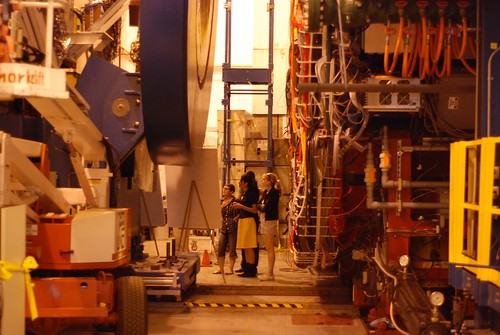 This afternoon, science historian (and SUNYSB philosophy prof) Robert Crease gave the 431st Brookhaven Lecture (he's given quite a few of these, but it's not surprising why) on "Birth of the Relativistic Heavy Ion Collider". Crease is our most notable lab historian and has been an important part of my understanding and appreciation of BNL. Today was no exception, as he covered the improbable chain of events, including some outrageous coincidences that led to the transformation of ISABELLE to RHIC. ISABELLE was a particle physics machine, which was plagued by technical difficulties in producing its accelerator magnets and was rapidly eclipsed by machines at CERN and FNAL even before construction got underway. Fortunately, as the physical infrastructure fell into place, a few visionary folks realized that various facilities of the lab could be yoked together to address the questions arising out of the emerging field of heavy ion physics. But Crease argued persuasively that it was only by the delicate maneuvering and effective leadership on the part of lab management (then lab director Nicholas Samios in particular) which led to a relatively smooth transition from a particle machine to a nuclear machine over the course of 5 days in July 1983.
This afternoon, science historian (and SUNYSB philosophy prof) Robert Crease gave the 431st Brookhaven Lecture (he's given quite a few of these, but it's not surprising why) on "Birth of the Relativistic Heavy Ion Collider". Crease is our most notable lab historian and has been an important part of my understanding and appreciation of BNL. Today was no exception, as he covered the improbable chain of events, including some outrageous coincidences that led to the transformation of ISABELLE to RHIC. ISABELLE was a particle physics machine, which was plagued by technical difficulties in producing its accelerator magnets and was rapidly eclipsed by machines at CERN and FNAL even before construction got underway. Fortunately, as the physical infrastructure fell into place, a few visionary folks realized that various facilities of the lab could be yoked together to address the questions arising out of the emerging field of heavy ion physics. But Crease argued persuasively that it was only by the delicate maneuvering and effective leadership on the part of lab management (then lab director Nicholas Samios in particular) which led to a relatively smooth transition from a particle machine to a nuclear machine over the course of 5 days in July 1983.Entering this story relatively late (only about to enter the 8th grade when all of this went down), it was very moving to understand better just how non-inevitable RHIC was, and how lucky we all are to have it here for us now. It also made me realize just how fragile these projects can be, no matter how big or "logical" they seem at the time. But having lived through the crazy times in 2000 when the machine finally rumbled to life, it makes the memories of the exhiliaration that was in the air that summer that much more meaningful. Also reminds one that the history of science isn't just what you find in Physical Review Letters.
















































